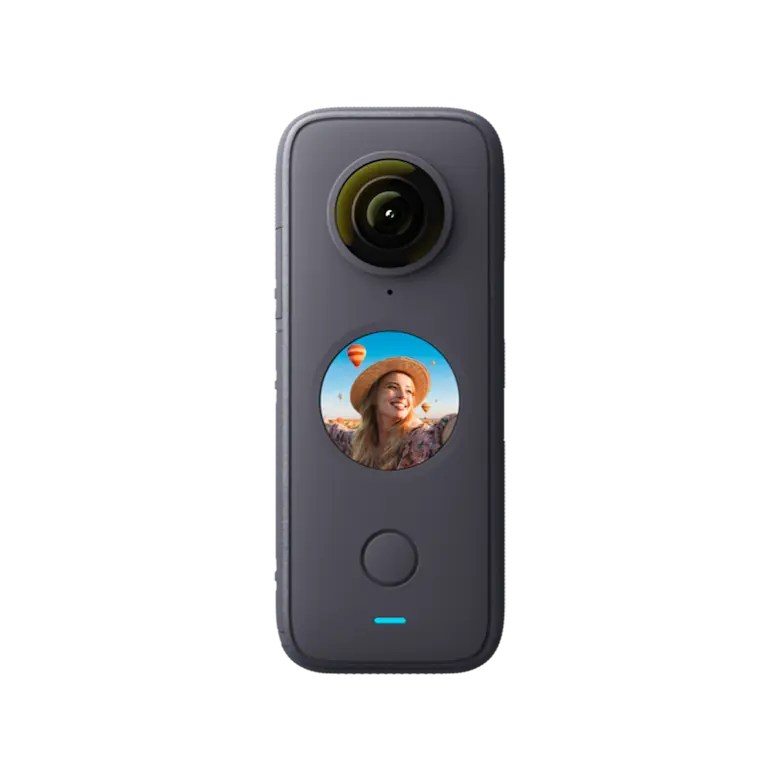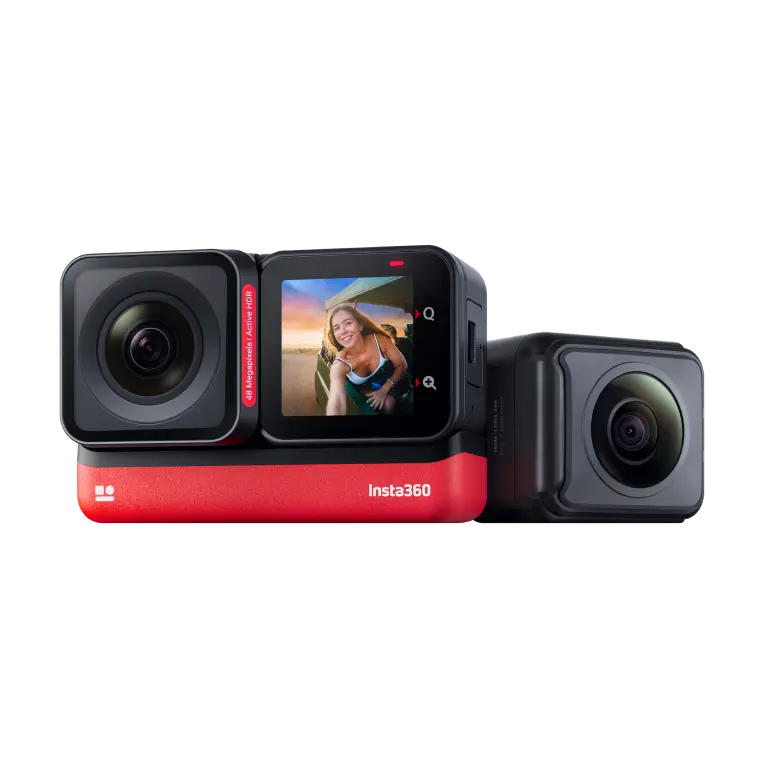Recent advances in Action Camera technology have been a real benefit for motorcycle filming.
Not only do they allow you to share the thrill of riding with people who stay at home to ‘cut their lawns’ (Google ‘Guy Martin quotes’), but they also allow you to relive treasured memories from stunning roads and vistas.
However, the real game-changer has been the development of 360 cameras, which can offer extraordinary footage. They offer views of your ride and surrounding scenery never seen before.
At first glance, they can seem expensive and complicated. However, they may not be so out of reach. Here we’ve created a simple guide and an overview of the top moto cameras currently available.
360 Cameras – Jargon Buster
Post Production Software – with 360 cameras, there are two types, one to set the camera’s views after filming, and the second is standard editing software to organise your clips and add sound/titles to your final movie.
Stitch Line – the line where the two 180-degree lenses meet creates a tiny gap where the software stitches the two images together
Auto-Stitch – where a 360 camera automatically blends the two views
Invisible Selfie Stick – a pole used in conjunction with mounts that allows you to have higher elevated views. The pole is hidden in the stitch line, making it appear invisible
Ram/Ball Mount – The simple clamp used to connect your camera to your motorbike
Frame Rate – the frame rate or frames per second (fps) determines how smooth the output film will be. Typical frame rates are 60, 50, 30 etc.
Stabilisation Rate – the speed that cameras can stabilise action shots to reduce judder and smooth out footage.
Resolution – the quality of final output; the higher the resolution, the sharper the image and the amount of storage required. Typically these are measured in 720p HD, 1080p HD and 4K Ultra HD.
Mega Pixels – the higher the number, the greater the quality of still photos
MicroSD Card – memory card for 360 cameras, typically ranging from 16Gb to 1Tb (A Terabyte = 1024Gb).
TFT Screen – Thin Film Transistor is the liquid crystal display used in laptops and electronic devices
360 Cameras Comparison Chart
Best 360 Cameras for Motorcyclists Reviewed
Insta360 X3 – Overall Best 360 Camera
The most recent addition to Insta360’s range, the X3 is a beefed-up version of the X2. With an upgraded image sensor.
The most significant differences are that the X3 now allows 4K filming in single lens mode (no single lens mode on the X2).
It now features amazing 72-megapixel stills, the highest in our review.
Plus, adding a new ‘Q’ button allows the user to set up pre-defined shooting modes that are easily accessed at the click of a button.
It has an increased screen size (from 1” to 2.29”), voice control, and WiFi connectivity, and offers up to 5.7k resolution in 360 mode.
Its 1800mAh battery boasts an 85-minute charge time that provides 81 minutes of filming. Although this is similar to the X2, Insta360 has maintained battery life even though it has a faster, more hungry processor.
Pros:
- Big screen and smooth menu selection
- 72Mp stills
- 4K Single Lens filming
Cons:
- Slightly thicker and heavier (30g) than the X2
- Slightly more complex to edit than other cameras
- Mobile editing requires a top-spec phone
GoPro Max – Best for Ease of Use
GoPro’s upgrade of their Fusion model is a well-priced 360 device from the King of action cameras.
With a solid 6K resolution, the Max offers a versatile 360 offering with outstanding stabilisation (as you would expect from GoPro).
It has received some criticism in that the standard ‘Hero Mode’ does not shoot at 4k and has a 1080p resolution. Not up to the standards of their Hero camera range. And it only takes 16.6mp still pictures.
Its ‘Quik’ app is intuitive, making this an excellent option for people who want to simply film great quality footage and quickly edit and upload.
Pros:
- 6 microphones
- Great stabilisation
- Ease of editing on the Quik App
Cons:
- No 4k std action camera mode (1080p in Hero Mode)
- Below par stills resolution (16.6mp)
- No PC editing App
Insta360 One X2 – Best Value 360 Camera
The follow-up to Insta360’s One X, the X2 is a pure 360 camera packed with features.
It has a small but perfectly formed colour touch screen, voice control, WiFi connectivity, and offers up to 5.7k resolution in 360 mode.
Its 1630mAh battery boasts an 85-minute charge time that provides 80 minutes of filming, which is 55% more than its predecessor.
Waterproof to 10m, its slightly unusual-looking form factor makes more sense when you grapple with how 360 cameras work.
Pros:
- Specific Motorcycle mounting package available
- Lots of creative options available via the Insta360 software
- Max IPX8 rated waterproofing (to 10m)
- Excellent 360 stabilisation
Cons:
- Slightly more complex to edit than other cameras
- Small screen
- No single lens option
Insta RS1 360 – Best Premium Pick
Also a recent camera to hit the market (at the time of publication) the RS1 is a top-end 360 camera for the more serious photographer.
Its superior ‘flow state stabilisation’ allows it to create some of the smoothest 360 film possible. And its Leica lens offers amazing 6K 360 footage and good low light filming.
It has a larger TFT screen than most 360 camera offerings, making it much easier to change settings on the go.
It also has an interchangeable lens feature, making it possible to upgrade in the future.
A clip-on memory module allows you to move footage from your camera to your phone instantly.
Pros:
- Beautifully crafted and well made
- Top-end resolution output
- Packed with AI features to improve footage in most conditions
Cons:
- Very expensive
- Not waterproof – just splashproof
- Heavy – not tested as a moto option
Insta360 One RS – Best for Photo Techies
Although it’s the third Insta360 camera on our list, the RS offers a unique package compared to the previous two.
The RS is a modular camera with a standard GoPro-style lens that offers a fantastic 4k resolution and 48mp stills.
The second mount (that costs extra) is a 360 lens that offers all the power and benefits of the One X2 camera.
If you’re feeling particularly flush, you can also purchase a third mount, a superior 1-inch wide Leica lens that offers wide angles, 5.3K resolutions and better low light filming.
Its rugged design and multiple mounting options make the RS an ideal Moto camera. And it’s waterproof to 5m.
Pros:
- Unique 3-in1 high-quality camera
- Offers more filming versatility
- 4K film looks stunning
Cons:
- Expensive, and the 1-inch lens significantly pushes up the price
- Not the easiest camera kit to carry around on a bike
- Editing larger res files requires a PC
Ricoh Theta X – Best for Quality
The upgraded version of Ricoh’s previous Theta V, the X model boasts some impressive stats in a decent photography package.
It has an incredible 60mp stills ability and can record 7K video. It’s a great choice if final quality is your main requirement.
It does have some drawbacks as a Moto option; it has a measly 30-minute battery life and is a bit of a porker, weighing in at 170g. Plus, it’s not waterproof, a problem as a Motorcycle option (a waterproof case is available).
It has an impressive 46Gb internal memory (as well as a MicroSD slot), which would be a massive benefit but would rely on having a good wifi transfer speed.
Pros:
- Big internal memory
- 60mp stills
- 7K Resolution
Cons:
- Not waterproof
- Expensive
- Poor battery life
Buyers Guide
Considerations and Cost
Installation and Mounting
One of my favourite things about 360 cameras is the endless mounting possibilities. As the camera doesn’t need a fixed viewpoint, you can get creative.
Most models come with a universal tripod socket that allows you to mount onto an inexpensive handlebar mount. The great thing about these mounts is that they clamp easily and can be moved from bike to bike.
Selfie sticks also add a lot of fun to filming, and you can attach them to the mount to create a telescopic arm, so it looks like the view is either behind, in front or above your bike.
Software
There are two things to consider with 360 camera software:
- You switch on and ‘Record First, Point Later’, making film editing a two-stage process.
- As it films a 360-degree picture, the positioning of the camera is almost insignificant, as it will capture everything in a virtual sphere
As software is a crucial consideration for your 360 camera. You need to consider this extra step in the process of having to ‘point’ your camera in the right direction before putting your final film together.
This is where Insta360 becomes a key player in this field. All of their cameras come with an excellent editing suite.
Here is an Insta360 tutorial from Simon Horrocks, showing a simple guide. After watching this, you can be up and running within 15 to 20 minutes.
You can also edit footage on your phone; some models allow this by simply moving your phone around in the footage to get the best angle. Garmin’s software is much more straightforward, so it can also be edited on your mobile.
Conclusion
360 cameras allow you to capture some genuinely stunning moto footage, but as with all technology, you pay for what you get.
However, companies like Insta360, dedicated to this specific type of camera, provide good, continually upgraded software and moto-specific mounting kits.
Until some other players join the market, if you want a 360 camera for your Motorcycle, our advice is to get an Insta360 X3 which offers a superb all-round package and is only marginally more expensive than the X2.
If you just want a standard camera with the best single lens quality, get a GoPro Hero-style action camera (check out our Best Motorcycle Cameras).







